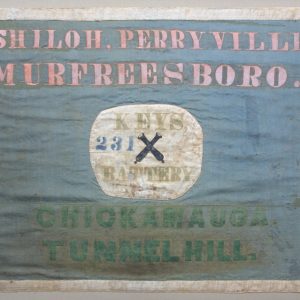calsfoundation@cals.org
Helena Artillery Battery (CS)
aka: Key’s Battery
The Helena Artillery Battery was a Confederate unit organized in Helena (Phillips County) in 1861. Known as Key’s Battery in honor of one of its commanders, the unit served for the duration of the Civil War.
Helena was a prominent secessionist stronghold before the outbreak of war, and several units were raised in the city after hostilities began. The battery was organized on April 27, 1861, and mustered in for three months of state service on April 29. The first commander of the unit was Captain A. W. Clarkson. Moving to Memphis, Tennessee, the battery was transferred to Confederate service on July 6, 1861. Some members of the unit declined to transfer from state service and were discharged at this time. The unit also lost some men when they transferred to Colonel Patrick Cleburne’s First Arkansas State Troops, which later joined Confederate service as the Fifteenth Arkansas Infantry.
The battery served as part of an artillery battalion under the command of Major Francis Shoup, which also contained two other Arkansas batteries. Armed with two six-pound guns and two twelve-pound guns, the battery stayed east of the Mississippi River for the remainder of its service. Serving in Kentucky, the battery moved with other units to Corinth, Mississippi, after the capture of Forts Henry and Donelson in February 1862. Participating in the Battle of Shiloh in April as part of Cleburne’s brigade, the battery retreated back to Corinth after the Confederate defeat.
While in Corinth, the Confederate army reorganized, and John Calvert was elected to serve as the new commander of the battery on July 2, 1862. Calvert was charged later in the year with drunkenness and agreed to refrain from drinking again while in Confederate service under the threat of forced resignation. The army underwent a reorganization while in Mississippi, and the battery remained part of Cleburne’s brigade. The Confederates retreated from Corinth in the face of an approaching Federal army that summer.
As part of the invasion of Kentucky in the fall, Calvert’s battery participated in the Battle of Perryville. Moving back into Tennessee, the battery fought at the Battle of Stone’s River, where it had three men killed and five wounded, with ten horses killed or wounded. Calvert was intoxicated once again at the battle, and he resigned his commission on February 6, 1863, after which Lieutenant Thomas Key took command of the battery.
Next participating in the Tullahoma Campaign but not seeing any action, the battery continued to serve with the same brigade, now commanded by Brigadier General Lucius Polk. Fighting at the Battle of Chickamauga, the battery had one man killed and five wounded while helping capture two Union guns and inflicting heavy casualties on other enemy forces. Later that year, the battery fought at the Battle of Missionary Ridge in the Chattanooga Campaign before moving into Georgia to help defend Atlanta. The battery joined a new artillery battalion with two other batteries from Mississippi and Alabama. Key was promoted to the rank of captain and commanded the new battalion. After fighting at the Battles of Peachtree Creek and Pickett’s Mill in the summer of 1864, most of the battery was captured at the Battle of Jonesboro. The flag of the battery was captured by the Fifty-second Ohio Infantry.
Exchanged shortly after its capture, the battery reentered service and fought at the Battle of Nashville in December 1864. The unit did not see any further action and was operating as two sections when it surrendered. One section surrendered at Macon, Georgia, while the other surrendered at Mobile, Alabama.
Key and other members of the battery who surrendered at Macon traveled to Nashville, Tennessee, before returning to Helena. Key lived in a number of southern cities after the war and founded the Southern Agriculturist journal. He died in Nashville in 1908.
The flag captured at the Battle of Jonesboro is in the collection of the Old State House Museum in Little Rock (Pulaski County).
For additional information:
Daniels, Larry. Cannoneers in Gray: The Field Artillery of the Army of Tennessee, 1861–1865. Tuscaloosa: University of Alabama Press, 2005.
McKay, John. Brave Men in Desperate Times: The Lives of Civil War Soldiers. Guilford, CT: Globe Pequot Press, 2006.
David Sesser
Henderson State University
 Civil War through Reconstruction, 1861 through 1874
Civil War through Reconstruction, 1861 through 1874 Military
Military ACWSC Logo
ACWSC Logo  Thomas Key
Thomas Key  Key's Battery Flag
Key's Battery Flag 




Comments
No comments on this entry yet.